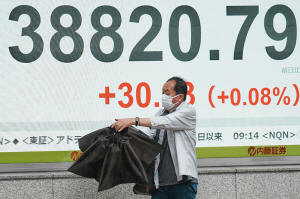Asian shares gain as investors shift focus to Federal Reserve, tariffs
[June 25, 2025] By
ELAINE KURTENBACH
BANGKOK (AP) — Shares rose in Europe and Asia on Wednesday after U.S.
stocks climbed to near their all-time high.
Oil prices gained more than 1% after falling about 6% on Tuesday on
hopes that Israel’s war with Iran will not hinder the global flow of
crude.
The fragile ceasefire between Iran and Israel, announced by Trump a day
earlier, appeared to be holding after a rocky start.
U.S. benchmark crude gained 1.8% to $65.54 per barrel, while Brent
crude, the international standard, climbed 1.7% to $67.30.
Lower oil prices could give the Federal Reserve leeway to cut interest
rates to help the U.S. economy. Its chair, Jerome Powell, said Tuesday
the central bank is waiting to see how the economy evolves before
deciding whether to reduce its key interest rate, a stance directly at
odds with President Donald Trump’s calls for immediate cuts.
“For the time being, we are well positioned to wait to learn more about
the likely course of the economy before considering any adjustments to
our policy stance,” Powell said in testimony Tuesday before the House
Financial Services Committee.
In early European share trading, Germany's DAX was flat at 23,642.70 and
the CAC 40 in Paris edged 0.2% higher to 7,632.78. Britain's FTSE 100
gained 0.4% to 8,789.92, while U.S. futures were little changed.
Shares advanced in Asia, where Tokyo's Nikkei 225 picked up 0.4% to
38,942.07.

The Hang Seng in Hong Kong advanced 1.2% to 24,471.70 and the Shanghai
Composite index jumped 1% to 3,455.97.
“The world can now move on to face other difficult choices like tariffs
and things like that. So I think the market is well on its way to
rebound and could again reach new levels,” said Frances Lun, CEO of GEO
Securities in Hong Kong.
In South Korea, the Kospi edged less than 0.1% higher to 3,108.25, while
Australia's S&P/ASX 200 also was barely changed, at 8,559.20.
Taiwan's Taiex gained 1.1% and the Sensex in India was up 0.8%. In
Bangkok, the SET added 0.3% after the Thai central bank opted to keep
its key interest rate unchanged.
[to top of second column] |

A person walks in front of an electronic stock board showing Japan's
Nikkei index at a securities firm Wednesday, June 25, 2025, in
Tokyo. (AP Photo/Eugene Hoshiko)
 On Tuesday, the S&P 500 climbed
1.1%, following up on big gains for stocks across Europe and Asia,
after Trump said late Monday that Israel and Iran had agreed to a
“complete and total ceasefire.” The main measure of Wall Street’s
health is back within 0.8% of its record set in February after
falling roughly 20% below during the spring.
The Dow Jones Industrial Average jumped 1.2% and the Nasdaq
composite rallied 1.4%.
The fear throughout the Israel-Iran conflict has been that it could
squeeze the world’s supply of oil, which would pump up prices for
gasoline and hurt the global economy. Iran is a major producer of
crude, and it could also try to block the Strait of Hormuz off its
coast, through which 20% of the world’s daily oil needs passes on
ships.
Now, oil prices have dropped so much in the last two days that
they’re near where they were before the fighting began nearly two
weeks ago.
With the global oil market well supplied and the OPEC+ alliance of
producing countries steadily increasing production, oil prices could
be headed even lower as long as the ceasefire holds and a lasting
peace solution can be found.
“Easing stress in energy markets is excellent news for everyone who
doesn’t want to see higher oil prices translating into accelerating
inflation and tighter monetary policy. So the market mood is
restored,” Ipek Ozkardeskaya, a senior analyst with Swissquote Bank,
said in a commentary.
The Fed has said repeatedly that it wants to wait and see how much
higher tariffs imposed by Trump will hurt the U.S. economy and raise
inflation before committing to its next move. So far, the economy
seems to be holding up OK, though a report on confidence among U.S.
consumers came in weaker than economists expected on Tuesday, and
inflation has remained only a bit above the Fed’s 2% target.
In currency dealings, the U.S. dollar rose to 145.10 Japanese yen
from 144.93 yen. The euro climbed to $1.1617 from $1.1610.
All contents © copyright 2025 Associated Press. All rights reserved |